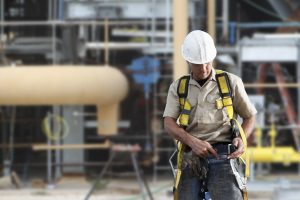
The construction industry contributes significantly to our built environment. However, it also carries inherent dangers.
Prioritizing safety and protecting workers is necessary for contractors and employers.
This article will discuss protocols for construction professionals to enhance workplace safety on construction sites.
According to the Bureau of Labor Statistics, construction has consistently ranked among the most hazardous industries in the United States. Construction accidents can have devastating consequences. Beyond the human cost of injuries and fatalities, accidents can lead to project delays, increased insurance premiums and hefty fines for non-compliance with safety regulations.
A strong safety culture, on the other hand, benefits everyone. Reduced downtime, improved morale and a healthier workforce contribute to a more productive and efficient work environment.
Before delving into specific protocols, it’s crucial to recognize the most common hazards construction workers face:
Falls From Height
This remains a leading cause of fatalities in construction. Ensure proper fall protection systems are in place, including guardrails, safety nets and personal fall arrest systems.
Understanding how to properly use ladders makes all the difference, especially for attic ladder installations with potential tipping hazards. Scaffolding safety protocols — including proper assembly, inspection and usage — should be strictly followed.
Electrocution
Electrical work carries a significant risk of serious injury or death. Establishing electrical safety protocols, using proper grounding techniques, and maintaining a safe distance from energized lines all help minimize risks of accidental electrocution on-site.
Struck-by Hazards
Falling objects, swinging materials, and vehicular accidents are major concerns on construction sites. Implementing traffic control plans, effectively securing tools and materials and designating safe work zones for pedestrians and workers are crucial preventive measures.
These are just a few of the major hazards. Respiratory hazards from dust and fumes, ergonomic risks associated with repetitive motions and trench collapses require similar attention to safety protocols.
The Occupational Safety and Health Administration (OSHA) plays a critical role in establishing safety standards for the construction industry. Staying up to date on relevant OSHA regulations and adhering to them is not just a legal obligation, it’s a cornerstone of a safe work environment.
OSHA provides a wealth of resources and training programs to help construction companies navigate safety obligations and ensure worker safety.
A strong safety culture starts with comprehensive training programs for all workers at all levels. Regularly scheduled training sessions ensure everyone understands safety protocols and sticks to them. Training methods can vary, such as incorporating classroom sessions, hands-on demonstrations and online modules — to cater to different learning styles.
Additionally, providing training in workers’ native languages ensures clear communication of safety procedures, lowering accidents on-site due to lack of understanding and miscommunication.
PPE can significantly reduce the risk of injury or illness on a construction site. Equipping workers with the right PPE, such as hard hats, safety glasses, gloves, respirators and high-visibility clothing, minimizes on-site accidents and increases worker confidence.
However, the effectiveness of PPE relies heavily on proper usage, care and maintenance. Training workers on how to wear and maintain their PPE is equally important.
Regular safety inspections are a proactive measure to take for identifying and mitigating potential hazards before accidents occur. Safety officers and crew leaders should conduct daily inspections, paying close attention to fall protection systems, electrical safety and proper material storage.
Clear and concise signage is another preventive measure to consider. Signage should warn workers of potential dangers, such as overhead hazards, electrical work in progress or restricted areas. Consistent use of standardized signage ensures clear communication between crews and project stakeholders.
Construction safety is a shared responsibility. The risk of accidents can be significantly reduced by fostering a strong culture of safety, providing thorough training, enforcing regulations and utilizing proper PPE and signage.
Consistent vigilance and proactive measures are key to maintaining a safe work environment. By prioritizing safety, construction companies not only protect their workers but also enhance overall productivity and project success.
Encouraging open communication and reporting safety concerns create a collaborative environment where safety is everyone’s priority.